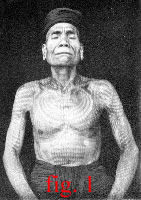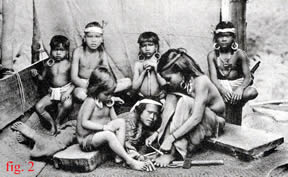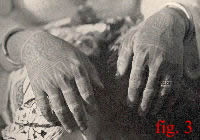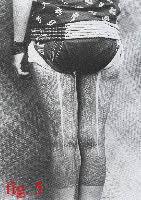
|
|
| Celeb Tattoos | Facts & Stats | Designs & Symbols | History | Culture | Links | Tattoo Galleries | Contact | |
|
|
In the Realm of Spirits: Traditional Dayak Tattoo in BorneoArticle by Lars Krutak Borneo - for many outsiders the name has been synonymous with a forbidding and isolated wilderness, a steamy rain-soaked place, dangerous and forlorn. While it was among the first lands in Asia to be visited by Europeans, it remained among the last to be mapped. Borneo is the third largest island in the world. Six major, and numerous minor, navigable rivers traverse the interior and function as trade and communication routes for the indigenous peoples who live here, namely the Dayak. Dayak, meaning "interior" or "inland" person, is the term used to describe the variety of indigenous native tribes of Borneo, each of which has its own language and separate culture. Approximately three million Dayak - Ibans, Kayans, Kenyahs and others - live in Borneo. Most groups are settled cultivating rice in shifting or rain-fed fields supplementing their incomes with the sale of cash crops: ginger, pepper, cocoa, palm oil. However several hundred Penan, nomadic hunter-gatherers, continue to follow a traditional lifestyle in the jungle, one that is rapidly vanishing. Aside from a few scattered reports of missionaries, traders, and a handful of explorers in the mid-19th century, almost nothing was known about the Dayak and their customs. To these outsiders only one thing was for certain: that the island was inhabited by "primitive" peoples who worshipped pagan gods and spirits and whose knowledge and skills made this land their home. By 1900, however, anthropological interest in Borneo peaked and became the focus of several museum expeditions by the Dutch and British. With the many ethnological accounts that followed, some of the most interesting material that was generated focused upon the traditional tattooing practices of the Dayak. Tattooing was believed to be a sacred activity that was connected to many aspects of traditional Dayak culture, especially spirit worship and headhunting.
Spirits, Gods, Ancestors, and the Circle of LifeAmong the Dayak, all life - whether animal, vegetable, or human - is endowed with a spiritual aspect. Spirits living in the jungle must always be propitiated and never offended. Recently, Vince Hemingson, who was traveling with the Iban, said that even when an individual wishes to urinate, he or she must ask the spirits for permission in order to give them an opportunity to move: "No one would ever want to pee on a invisible spirit that is sitting directly in front of them and certainly no one would ever piss on a tree, you never know whose house that tree might be [and] I certainly didn't want to pee on anyone's house." Spirits (Iban: antu), both good and bad, exercise many powers; they provide the techniques of rice cultivation, the techniques of textile weaving, and the techniques of tattooing. Spirits usually come to individuals through dreams and even tattoo artists are under the protection of a particular spirit. Dreams are believed to be revelations sent by the gods, sometimes by deified ancestors, and all Dayak are guided by them in their daily affairs. Dayak heaven is a universe filled with the spiritual energies that charge with life-power most existing beings and things. This divine realm, removed from secular time and the laws of this world, is the abode of gods and ancestors who grant privileges to those who maintain the proper balance of life throughout all of its stages. At birth, all Dayak are endowed with the perfect gifts of nature: mind, body, and several souls. Each of these components are essential for remaining "complete" throughout life experience, since completion is necessary for one to enter the sanctity of the afterlife. According to the beliefs of the Iban, one of the souls of a person resides in their head and by taking someone else's you capture their soul as well as their status, strength, skill and power. Thus, it is not surprising that human heads, once taken and preserved, were respected in ritual; their spirits became adopted members of the group that took them and were persuaded to aid their captors in many ways. Most Dayak, living their lives in strict accordance to the divine norms and commandments by which the gods and ancestors had lived their lives, relied upon human sacrifice to propitiate the good will of their masters. Headhunting, the ritual component, served to maintain the prosperity of the group by ensuring agricultural and community fertility. In the eyes of the gods and ancestors, the taking of fresh heads was not only pleasing - it was duly rewarded with many gifts. For example, the divine indicated locations in the forest where fields should be cleared and planted; they protected the rice fields against crop failure; they lent their diagnosis in illness; and they accompanied men in war or on the headhunt to insure success. Headhunting was therefore an institution believed to maintain balance and harmony in the Dayak cosmos and oftentimes a man's status was not established until he had proven success in headhunting itself. The most important symbol marking participation in the headhunt was tattoo
(Iban: pantang). Among the Kayan, anthropomorphic figures were tattooed onto the fingers and were known as tegulun. Although they denoted having taken a head, tegulun possibly represented a sacrifice to a helper spirit that in former times was propitiated by killing a slave upon the construction of a new longhouse. Other
Shamans, Sickness and the Land of the DeadShamans (Iban: manang) were revered individuals in the Dayak community. They possessed the gifts of prophecy and healing and were sometimes feared by the populace because of their affiliation with supernatural spirits. Shamans were not only doctors who diagnosed illnesses and prescribed remedies for the sick, but were interpreters of vast, unknown spiritual forces that controlled the weather and food supplies. Serving as liason between the supernatural and the people, the manang witnessed and communicated with several of the spiritual and mythological beings of Dayak belief. Many of these spirits, which included those of plants and famed ancestors no longer living, were captured and utilized as assistants (Iban: antu nulong). In Iban belief, some physical ills are manifestations of evil spirits (antu) that are occasionally attracted to individuals who directly reflect moral inadequacies. If the shaman fails to affect a cure, either by propitiating the antu with sacrifices, enticing it into a wooden figurine, or by barking, growling and in some cases even attempting to kill it, a name changing ceremony is then performed and the afflicted may be given a new tattoo near the wrist. The new name serves to conceal the
Although the apotropaic aspect of Dayak tattoo has been discussed, specifically as a remedy against supernatural possession resulting in disease, tattooing was also an initiation rite involving the entire community longhouse. Tattoo operations were not carried out in the longhouse itself, rather they took place in a specially built hut among some groups. During the entire ritual, the male members of the family dressed in bark-cloth. Bark-cloth was normally placed on the corpses of village leaders at their funerals or worn by widowers. At other times, headhunters used bark-cloth during ceremonial occasions. Therefore, it seems that the association between tattoo and bark-cloth indicates that tattooed individuals pass through a communally recognized symbolic death in order to pass into a new stage of life. Not surprisingly, each Dayak community is comprised of individuals both living and dead, since those members who left this world forever now dwell in the community of the ancestors - the village of the dead. It is here, the perfect world were houses are magnificently built, the trees bear perpetual fruit, and the pathways are paved with gold and jewels, that each Dayak individual yearns to be in the afterlife. Notwithstanding these concepts, tattoos and death were inextricably bound in other respects. When the Kayan soul left its human host, it journeyed through the murky depths of the afterlife in search of the village of the dead. Kayan souls encountered many obstacles on their supernatural flight: The River of Death the most formidable. According to tradition, only the souls of tattooed women who provided generously for their families and headhunters who possessed hand tattoos - a token of their success - were able to cross the log bridge that spanned these dangerous waters. Maligang, the malevolent guardian of the bridge, oftentimes refused such passage forcing souls to descend into the river's depths to be eaten by Patan, a giant catfish. However, if the lingering soul was properly tattooed, it was free to pass into the darkness that awaited it on the other side. Although this dim world was silent and discomforting, the soul's tattoos began to burn brightly, in turn, guiding the incorporeal spirit to its final resting place among the ancestors. A Spiritual ArtformDayak tattoo is a spiritual artform that merges images of humans, animals, and plants into one unit, expressing the proliferation of life and the integration of living and spiritual beings in the cosmos. Death and fertility were the primary axes around which tattoo creativity spiraled. Tattooing offered visual testimony to the refusal of Dayak individuals to accept the finality of death and assert the indestructibility of their being. By emulating the life of the gods in everyday ritual, the Dayak procured their own form of divine power that ensured the perpetuation of human life in a continuum of eternity. Therefore, tattoos were articulating symbols inscribing implicit Dayak ideologies of existence upon the living canvas of human flesh. Literature- Graham, P. 1987. Iban Shamanism: An Analysis of the Ethnographic Literature. Canberra: Research School in Pacific Studies, Australian National University. |
|
Back to BORNEO Land of the HeadhuntersOther tattoo articles by Lars Krutak
|
|
| Celeb Tattoos | Facts & Stats | Designs & Symbols | History | Culture | Links | Tattoo Galleries | Contact | |




